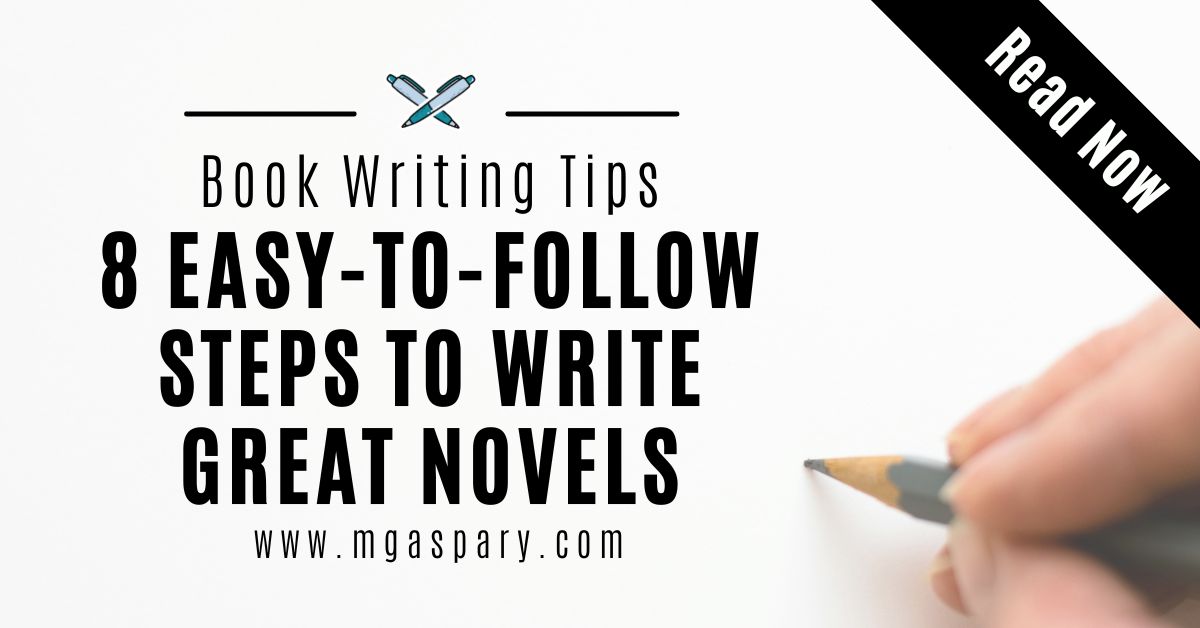The process of writing a novel is as long as a long road showing you nothing but a thick fog of cluelessness.
Yet, with tenacity and persistence, you can overcome the difficulty and see an overwhelming beauty you have never seen before.
Table of Contents
- The Process of Writing A Novel
- Step 1: Be observant.
- Step 2: Build your premise.
- Step 3: Develop exciting and realistic characters.
- Step 4: Define your settings.
- Step 5: Don’t be afraid to rewrite scenes.
- Step 6: Create a novel outline.
- Step 7: Don’t forget the attention-getting book titles.
- Step 8: Design your book cover. (Optional)
- Writing a Book – Final Thoughts
Do you think you can write?
If so, are you willing to get through the hellish process of writing a novel…or not?
Let’s face it.
Writing lengthy literature, a novel, isn’t something everybody does. It takes a lot of effort and commitment to start and end without distractions.
For years of writing lengthy stories on Wattpad, even I can testify it’s not someone’s cup of tea. But I did. So can you.
Now, you’re here because you want to know how to write a novel and begin your lifelong writing endeavor this year.
Are you ready? Let’s get started. Shall we?
The Process of Writing A Novel
Remember that authors don’t have the same strategy regarding the early stages of novel writing. Others sit in a coffee shop and gather as many ideas and information first before they start writing.
Other writers prefer interviewing people or observing real-life situations to get started. In my case, I like listening to music to get the feel of the book.
I have a few suggestions to get the feel of writing if you may ask whether to do every single step, no.
All you need to do is to be aware of what others have done and apply some that will work for your writing process.
Do you get me?
Step 1: Be observant.
First, you need to activate your senses: sight, smell, touch, hearing, and taste. You have to be more observant than ever, gather as many ideas as possible, and record them in your pocket notebook or phone.
If you can’t think of what to write, I wrote a separate post that gleans the creative ways most authors do to find their next novel inspirations.
Find the 61 creative but effective ways to find your next book idea.
| Exercise: Gather as many book concepts as you have in mind today (while you’re reading this post). Write them in your notepad in bullet form to make it easier. The sky’s the limit. |
Step 2: Build your premise.
Building a solid foundation for your book plays a significant role in writing. As a writer, you must know where your story starts and ends in the long run.
Crafting a premise is like creating a blueprint for your whole novel. You need to see the overall picture of your story before you begin.
Of course, when you write the story, there will be inevitable changes in between. But the premise isn’t.
Your conflict and characters’ goals remain, except how you write the scenes to reach these goals changes. Not the blueprint itself.
So, how do you write a premise?
You can do this step, which I found interesting to follow. Though you don’t have to follow the steps, it’s a big help for you to start.
- Step 1: Know the “when” clause to begin a clear description of your main character.
- Step 2: Add another character to create tension.
- Step 3: Add “leading to” to hint at the main character’s goal.
- Step 4: Add the word “until” to introduce the conflict.
- Step 5: Combine all the elements together.
For example, I wrote a sample premise using the abovementioned steps. It’s the premise of my Wattpad book “Titan’s Curse.”
Step 1: “When an arrogant CEO receives a curse…”
Step 2: “When an arrogant CEO receives a curse, he teams up with his newly hired intern…”
Step 3: “Until they meet the witch responsible for the curse…”
Step 4: “Leading to the unexpected quest to find answers…”
Step 5: “When an arrogant CEO receives a curse, he teams up with his newly hired intern leading to the unexpected quest to search for answers until they meet the witch, who’s responsible for the curse.”
You see from the combined elements from steps 1 to 4, you notice the main characters.
The protagonists and antagonists, the conflict, the setting (implied in modern times and the corporate workplace), and the goal (meant to be released from the curse).
| Exercise to try: Using the steps above, create your book premise using the chosen concept in Step 1. |
Step 3: Develop exciting and realistic characters.
Your characters drive your stories. Everything that happens throughout the novel depends on how well their decision-making is.
If they choose to fight over difficult circumstances, the chances of having an excellent resolution are high. Otherwise, don’t expect a desirable conclusion.
Most writers neglect this part. It’s every writer’s pet peeve. And the sad thing is it happens so often that I couldn’t help but voice it out here. For instance, their characters behave inconsistently throughout the story.
With that, defining your characters inside and out makes a big difference. You don’t have to fall into the same trap as other authors.
So, how do you create a character profile?
All you need to consider are the following:
- Character’s Physical Attributes (hair color, eye color, skin color, etc.)
- Character’s Personality And Behavior (tone of language, mannerisms, vulgarity, personality, likes and dislikes, interests, talents, etc.)
- Characters’ Background And Vulnerability (the backstory of your villains, for example)
One Wattpad author shares her strategy to develop a solid and exciting character. Here’s how she does it. She fills in the form, as you can see below per character.
CHARACTER NAME:
Nickname:
Age:
Work:
Height:
Weight:
Birthday:
Zodiac:
Hair color:
Eye color:
Facial features:
Physical traits:
Habits:
Personality:
Positive:
Negative:
Parents:
Sibling/s, if any:
More information:
Once you define the overall character profile for each of the main characters, who will play a prominent and minor role in your novel, you will have a clearer sense of how the conflict spices up, given the flaws and limitations of each character. Otherwise, it will bore your readers.
Keep in mind when crafting your characters, you also need to play with irony. Place them in ironic situations to test their values.
If she’s a genius, give her a dumb or clumsy best friend.
If he’s arrogant and full of himself, give scenarios wherein he’s getting insulted, but he can’t fight back. Something like that.
These will keep the readers going. They want to find out how your character ends up in the story. Keep them curious.
Keep the readers on fire!
| Exercise to try: Use a separate sheet and write your character’s profile for all your main characters, the protagonist and the antagonist, using the above format. |
Step 4: Define your settings.
When crafting your novel’s settings, you must inform your readers where and where your story takes place.
Is it during historical times or modern times? You have to be clear on this at the beginning of your story.
To make it easier for you, others have done the same as well, they visit real-life locations to tickle their creativity.
In my case, I visit places to have a feel of the overall story. As I mentioned earlier, others rely on imagination, especially fantasy writers.
For example, J.K. Rowling fulfilled her novel settings in Harry Potter while she rode a train for a long-distance ride.
| Exercise to try: Decide where you want to take your readers based on the concept and premise you have on hand. From there, describe where and when your story will take place. |
Step 5: Don’t be afraid to rewrite scenes.
The scene sketches are the scenes you wish to include in your book. Any random events you want your characters to experience. It could also be a series of rough ideas your story should contain.
During the writing process, there are times when one of these ideas won’t be included in the story and perhaps in the next book. The important thing is you note the essential scenes that your book will contain.
This is what I do with my book “Accidental Quest.” I used index cards to record the scenes I wanted to write. At the top portion, I write the main event; underneath are the notes or highlights of that event in bullet form.
Do you think this works for you, too?
| Exercise to try: Have a set of index cards with you to write all the main scenes you want to include in your book based on the concept and premise. You don’t have to make it perfect and final. This is your guide to review later on. |
Step 6: Create a novel outline.
As the name suggests, it’s an outline. So, it’s oftentimes in bullet form like I do with my books. But you don’t have to be so fancy here.
All you need are each chapter’s main highlights or thoughts. This is where your index cards take their role in the whole process.
By the way, why do you need to create a novel outline for your works?
There are 2 clear reasons why you need to do it before the writing phase:
- For organization and to avoid a cluttered plot (most writers’ pitfalls)
- For your professional editor’s reference, when she takes over your work
We do the novel outline per chapter. Derek Murphy, one of the most prolific authors I know, defines it as the plot outline.
By borrowing his idea of dividing the plot planning into 3 sections, I developed the “3-Act Storytelling Technique,” wherein you follow the 3 parts in the planning process: Seek, Achieve, and Lose.
I got this idea from observing used techniques published authors apply in their books. And by doing this over the years, I summarize everything with the image below.
| Exercise to try: Use another separate sheet for your novel outline. In this section, you have to be a bit specific regarding details to ensure the organization of your writing. Remember, this serves as your professional editor’s guide during the editing phase of your book. |
Step 7: Don’t forget the attention-getting book titles.
A well-chosen book title can affect sales.
This is why publishers want to make sure your book title can attract more sales along with the book design.
The moment they see your book on the bookshelves, the readers will know the book and buy it. This is the mind map of the publishing industry.
Of course, you can’t develop it when you’re still writing it or have just finished the first draft. The finalized book title usually comes after a lot of self-editing and the professional editing phase.
Ultimately, the publishing company will have the final word on the title before publishing your book. If what you have in your draft matches their expectations, they may retain the title.
The point is your book title must speak for the plot itself. This is why your premise is essential, which I mentioned earlier in the post.
You have to go back to your premise and review your book title if they match or not.
Recommended book title generators:
As a start, I have here the following book title generators you can take advantage of and use as a draft.
The generated titles don’t necessarily become your final book title. It’s just to give a picture of your book in words based on how you perceive the story as a whole.
- Reedsy Book Title Generator
- Portent Title Maker
- Fantasy Name Generators (It says fantasy but has features for other genres).
- Serendipity (only fantasy book titles)
- Starmanseries
- Book Title Generator
- Adazing
| Exercise to try: Choose keywords apt for your story concept. From there, gather as many titles as you want using the book title generators I provide until you see one that speaks your story the best. |
Step 8: Design your book cover. (Optional)
If you’re a Wattpad writer like me, designing a book design is necessary. Before I publish my work for public reading, I have to make sure my book covers speak right to my readers (to my followers).
But then, deep down inside me, I know the need for professional book designers to come in, primarily if my works are published on Amazon.
For now, you can temporarily design your book cover if you want. But this isn’t necessary. If you want to do it, you have the following options:
- Canva (my top recommendation)
- Adobe InDesign
- FlipHTML5
- QuarkXPress
- Adobe FrameMaker (similar to InDesign)
- Scribus
Once you decide to let a professional layout artist come in and take over the book design, you can go to Reedsy, my favorite hub for professionals.
They have a lot of professional editors, book designers, copyeditors, and others for fiction and non-fiction works.
Writing a Book – Final Thoughts
Before you worry about your readers and how lengthy your book is, take care of the basics first. In writing a book, what matters most is the writer’s skillful storytelling.
Everything starts when you start writing something. You can’t edit or worry about your book’s performance when you have nothing to read or evaluate.
Follow the process with patience and determination. Novel writing entails attitude. You can’t finish anything if you keep perfection blocks your way. Loosen yourself and start typing in the words you want.
Begin with the concept, then craft the premise, craft your character’s profile, decide where you want to take your readers in the story, decide what kind of scenes you like to include in your book, create your novel outline, all the way through making the book cover and book title.
Each step takes time. It’s not like reading this post, and you’re done.
I’m writing this post to give you a gist of the whole thing. It’s up to you to get serious with your writing this year for whatever reasons you may have right now.
Now, it’s your turn to write your journey. The future of your writing career lies in your hands.
If you like this post, share it with your friends and family. Feel free to leave your thoughts in the comment section below. 🙂




Leave a Reply to kitchen Cancel reply